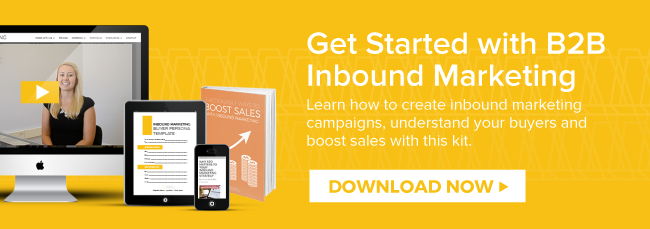The Problem With B2B Inbound Marketing

Inbound marketing has become increasingly popular among B2B companies because it helps them drive quality leads and close more sales. We love inbound marketing at Accelity, and we’ve seen great results from it, both internally and when working with our clients. However, B2B inbound marketing isn’t a perfect system, and may not be a fit for everyone. That’s why I’m walking through the problems we’ve found when implementing inbound marketing.
Building the strategy is a time commitment
Any quality strategy takes time, and inbound definitely falls under this category. Planning is essential to effectively implement it. If you need immediate results, inbound might not be for you. To give you an idea of the time commitment involved, here are the typical steps many inbound marketers take to fully execute inbound:
- Setting SMART goals for your business
- Building buyer personas
- Creating a content matrix and/or roadmap
- Building a lead scoring strategy
- Brainstorming the first monthly campaign
...and monthly campaigns usually entail:
- Identifying your audience
- Doing keyword research
- Creating a content offer to gate
- Building your landing page and thank you page
- Writing blog posts that point to the content offer
- Sharing on social media, paid ads and other platforms
- Building emails to promote your offer
Some B2B companies (especially startups and small businesses) don’t have the resources to commit to the above steps. The good news is that many third party inbound marketing experts have implementation and continued execution of B2B inbound marketing campaigns down to a science, and are affordable even for small businesses.
If you’re intimidated by the time commitment, you can start small (there are no hard and fast rules to the size of your inbound campaign). Just remember to test your results; doing this will help you justify your decision to further explore this strategy.
It can get costly
The goal of inbound marketing is to attract and nurture new quality leads and convert them into customers, and this strategy isn’t always cheap. Remember, the cost for acquiring a new customer is 5-10x more expensive than retaining and upselling an existing one. If your purse strings are tight, you might want to explore other marketing options, like creating marketing campaigns that upsell or cross-sell to existing customers.
However, if you can make the commitment, we’ve found that the ROI is worth the initial cost. Here are some of the results we’ve seen from our clients after implementing inbound over the course of a year:
- 3x the website visits
- 1200% increase in resource downloads
- 5x the email clicks
- 360% increase in new contacts
Results take time
Inbound leads are higher quality, so it takes time to ramp up your strategy and nurture them so that they hit qualified status. You need to stick to your strategy to see results. Running sporadic monthly campaigns is fine, but it won’t produce consistent qualified lead conversion rates. If you don’t have the resources or time to dedicate to monthly campaigns, then B2B inbound marketing may not be ideal for you.
As I’ve said above, you can start small if you don’t have the capacity to build a complete inbound campaign. Try creating one blog, instead of three, to promote your offer, or post on social, but don’t promote via paid ads. Tweaking your process is okay, as long as you stay consistent over time.
Another thing to note is that you shouldn’t completely abandon other marketing practices. Inbound and outbound strategies work well together, so consider using both (it’s not an either/or choice).
B2B inbound marketing is a powerful strategy, but every business owner and marketer should be realistic about the commitment and the time it takes to see results. Inbound isn’t for everyone, but if you choose to dedicate time and resources to it, you’ll see positive long-term outcomes.
If you’re curious about how to get started with inbound marketing, reach out to us here. Do you agree or disagree with my thoughts on inbound? Share with me in the comments below.


